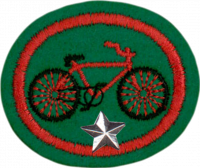Difference between revisions of "AY Honors/Cycling - Advanced/Answer Key 2/es"
(Created page with "</noinclude> <!-- 9. Repasar las normas de cortesía y seguridad que se usan al andar en bicicleta. ¿Cuáles son las normas de la carretera para ciclistas en su área local? -->") |
(Created page with "</noinclude> <!-- 10. ¿Cuáles son las ventajas de aprovechar la corriente de aire? Conocer la forma segura y adecuada de hacerlo. -->") |
||
| Line 181: | Line 181: | ||
</div> | </div> | ||
| − | + | {{clear}} | |
| − | |||
| − | |||
<div lang="en" dir="ltr" class="mw-content-ltr"> | <div lang="en" dir="ltr" class="mw-content-ltr"> | ||
| Line 201: | Line 199: | ||
</div> | </div> | ||
| − | + | <noinclude></noinclude> | |
| − | <noinclude | ||
| − | |||
{{CloseReq}} <!-- 9 --> | {{CloseReq}} <!-- 9 --> | ||
{{ansreq|page={{#titleparts:{{PAGENAME}}|2|1}}|num=10}} | {{ansreq|page={{#titleparts:{{PAGENAME}}|2|1}}|num=10}} | ||
| − | <noinclude> | + | <noinclude></noinclude> |
| − | </noinclude> | + | <!-- 10. ¿Cuáles son las ventajas de aprovechar la corriente de aire? Conocer la forma segura y adecuada de hacerlo. --> |
| − | <!-- 10. | ||
| − | |||
| − | |||
| − | + | {{clear}} | |
| − | |||
| − | |||
<div lang="en" dir="ltr" class="mw-content-ltr"> | <div lang="en" dir="ltr" class="mw-content-ltr"> | ||
Revision as of 04:46, 24 May 2021
Nivel de destreza
2
Año
1976
Version
31.10.2024
Autoridad de aprobación
División Norteamericana
For anyone riding on a sidewalk:
- Watch for vehicles coming out of or turning into driveways.
- Stop at corners of sidewalks and streets to look for cars and to make sure the drivers see you before crossing.
- Enter a street at a corner and not between parked cars. Alert pedestrians that you are near by saying, “Excuse me,” or, “Passing on your left,” or use a bell or horn.
For more information on bicycle safety, visit the National Highway Traffic Safety Administration (NHTSA) Web site at: www.nhtsa.dot.gov
In cycling, the main (largest) group of tightly packed cyclists in a race is called a peloton, while cyclists riding in straight-line formation, each (but the first) drafting behind the one in front of him, is called a pace line.
Drafting can be cooperative, in which several competitors take turns in the lead position (which requires the most effort and energy consumption). Or, it can be competitive or tactical, where one competitor will try to stay closely behind another leaving him or her more energy for a break-away push to the finish line.
Different types of cycling have different clothing and protective gear. However, some are common to all cycling:
- Helmet - protects head in the event of an accident, can provide sun shade and protection. Are required in some places, or for some ages.
- Gloves - protects hands, usually the first body part to hit the ground in the event of an accident; padding in gloves eases fatigue and can provide some shock-absorption. Gloves protect road-riders' hands when cleaning glass, gravel, etc., from tires while riding.
- Glasses - keeps bugs and debris out of the eyes, and keeps eyes from watering in cold weather or high-speed rides. Sunglasses reduce glare and keep eyes from becoming over-tired.
General safety equipment which is not required, but used by some cyclists includes:
- Mirrors - these attach to the handlebars or rider's helmet for seeing cars/cyclists behind. These can be important for commuters, bicycle messengers, or those cycling in urban/suburban environments.
- Bells - mountain bikers on hidden single-track trails, or cyclists in busy areas may use handle-bar mounted, finger-activated bells to warn of approach.
Riding at night has it's own safety requirements:
- Front and rear lights - these are required in some locales after sunset.
- Reflectors - mounted on wheels, pedals, frame, seatpost or handlebars are the most common.
- Reflective clothing - many makers of cycling clothing integrate reflective tape or strips on shoes, pants/shorts, shirts/jackets or helmets.





